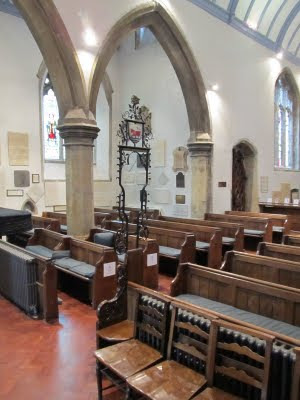St Mary- at-Hill Church and St Olave’s Church, Hart StreetTwo very different churches seen whilst walking from Fenchurch Street Station to Monument.
John Betjeman described St Olave’s as “a country church in the world of Seething Lane’. The church is first recorded in the 13th century as St Olave-towards-the-Tower. It is dedicated to the patron saint of Norway, King Olaf II of Norway, who fought alongside the Anglo-Saxon King Ethelred the Unready against the Danes in the Battle of London Bridge in 1014. He was canonised after his death and the church of St Olave's was built apparently on the site of the battle.The Norwegian connection was reinforced during the Second World War when King Haakon VII of Norway worshipped there while in exile.
Saint Olave's was rebuilt in the 13th century and then again in the 15th century. The present building dates from around 1450. The church is a rare example of the mediaeval churches that existed before the Great Fire of London in 1666. The flames came within 100 metres or so of the building but then the wind changed direction, saving a number of churches on the eastern side of the City.
The church was severely damaged in the bombing of World War II, but enough of the fabric and original masonry was spared to permit the building to be restored in the 1954.
The exterior is in the Perpendicular Gothic style. with a squat square tower of stone and brick, the latter added in 1732.


It is famous for the macabre 1658 entrance arch to the churchyard, which is decorated with grinning skulls.

The interior of St Olave's only partially survived the wartime bombing; much of it dates from the restoration of the 1950s. It is nearly square, with three bays separated by columns of Purbeck limestone supporting pointed arches. The roof is a simple oak structure with bosses.

The view down the nave towards the altar and east window.

The east window. The two central lights represent Christ as Saviour and Christ as Victor. The left panel is of St Olave over the arms of King Haakon VII and the left is St George over the arms of Queen Elizabeth II. It was designed by A E Buss.

From left to right: The pulpit was acquired in 1857 from St Benet’s Gracechurch Street and is reputed to be by Grining Gibbons (1648-1721 whose work is also found in St Pauls cathedral and Hampton Court Palace. One of two restoration stones: This is the ‘Stone of History’ which records the dates of the successive churches on this site. (the other was laid by King Haakon VII). Above the stone is one of four Sword stands which date from the C18.

The door to the vestry is thought to be older than the present church, dating back to the original C13 stone building.


The church was designated a Grade I listed building on 4 January 1950. I think John Betjeman nearly got it right - 'a
City of London version of country church in the world of Seething Lane’ might be better.
Between 1948 and 1954, when the restored St Olave's was reopened, a prefabricated church stood on the site of All Hallows Staining -- . This was known as St Olave Mark Lane. The tower of All Hallows Staining was used as the chancel of the temporary church.

After leaving St Olave’s I walked along Great Tower Street and glancing south, The Shard’s progress could be seen looking down the street called ‘St Mary at Hill’. Half way down the street is the east façade of St Mary-at-Hill’ church.

A small sign then directs you through some iron gates to an open area by the north wall – but you could not get into the church from there.

A walk back around three sides of a square brings you to Lovat Lane and the west door under the tower. This was open but the church was being used for a rehearsal and I could not go in!
St Mary- at-Hill has existed for nearly a thousand years serving in the Parish of Billingsgate. The Great Fire of London (1666) started in Pudding Lane, a stone’s throw away from St Mary-at-Hill. The Fire had consumed the interior of the church leaving only parts of the walls and the brick work of the tower. It is thought that Robert Hooke may have supervised the rebuilding of St Mary’s although Christopher Wren rebuilt the interior.

Utilising the previous fabric as far as possible, the original north and south walls were reconstructed, but the building was extended a little to the east. An ornate main frontage of exposed stone was built on St Mary at Hill.

St Mary-at-Hill was one of the first churches rebuilt after the Fire, and was completed in 1677. The tower and steeple was replaced by George Gwilt’s square brick tower in 1787-9.
During the night of the 10th May, 1988 a fire broke out on the roof. This once again devastated the interior and although St. Mary-at-Hill ‘rose again’, the reredos, pulpit, box pews and organ sustained considerable damage.
Writing before the most recent fire Sir John Betjeman said of the church “This is the least spoiled and the most gorgeous interior in the City, all the more exciting by being hidden away among cobbled alleys, paved passages, brick walls, overhung by plane trees…”. Despite appearing as one of Simon Jenkins 1000Best - I will need to visit again to be convinced.


 St Just Church, Gorran Haven - more correctly known as the Chapel of St Just.
St Just Church, Gorran Haven - more correctly known as the Chapel of St Just.

























































